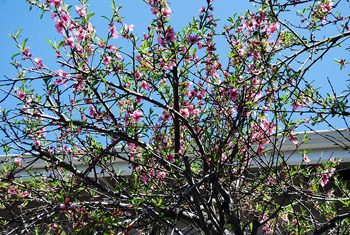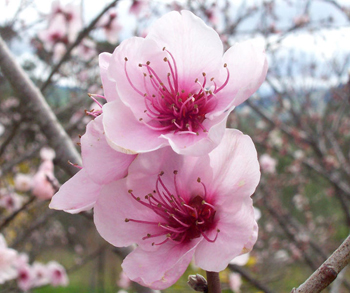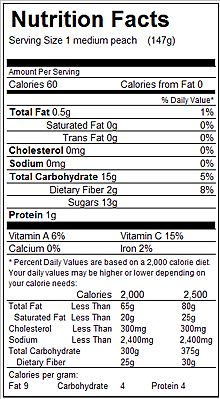Contents:
Common Names | Parts Usually Used | Plant(s) & Culture | Where Found | Medicinal Properties
Legends, Myths and Stories | Uses | Formulas or Dosages | Nutrient Content | Bibliography
Scientific Names

- Prunus persica L.
- Rose family
Common Names
- Peach
- T’ao (Chinese name)
Parts Usually Used
Leaves
Back to Top

Description of Plant(s) and Culture
The peach tree is a well-known fruit tree; the tree may grow as high as 20 to 25 feet, but orchard trees are usually kept shorter. The leaves are thin, serrate, and oblong-elliptic to lanceolate. The flowers are a delicate pink. The tree flowers in spring and harvest of fruits is in the autumn.
Another variety: Wild peach (P. andersoni), called Tsanavi by the Paiutes, who make tea from the branches for colds.
Back to Top
Where Found
Widely cultivated in temperate and warm regions all over the world. In the United States, California is the predominant peach-producing state. The peach is indigenous to China.
Back to Top
Medicinal Properties
Diuretic, expectorant, laxative, sedative
Back to Top

Legends, Myths and Stories
Culpeper, and also the Herbalist Almanac, state that if the kernels of peaches are bruised and boiled in vinegar until they are thick, then applied to the head, it make the hair grow again in bald places, or where the hair is too thin.
The peach is indigenous to China. The wood is used in fortune telling; the flowers are supposed to have some supernatural power in driving away the demon of ill health; the leaves are regarded as a parasiticide. Slips of peach wood were used as charms against evil spirits. The slips were worn on the person, attached to the door of the house, or set out in the rooms of the house.
Back to Top
Uses
Peach leaves stimulates the flow of urine, they are mildly sedative, and helpful for various nervous conditions. They can be used for chronic bronchitis and chest congestion. The leaves help to relieve vomiting and morning sickness, but their dosage must be regulated to avoid excessive laxative action. Powdered dried leaves have sometimes been used to help heal sores, ulcers and wounds.
Back to Top
Formulas or Dosages
Infusion: steep 1 level tsp. leaves in 1 cup boiling water. Take 2 to 3 cups in the course of a day, as needed, with the first cup before breakfast.
Tincture: for nausea, take 2 to 15 drops in water, 30 minutes before meals or as needed.
Back to Top
Nutrient Content

Bibliography
![]() American Folk Medicine
American Folk Medicine, by Clarence Meyer, Meyerbooks, publisher, PO Box 427, Glenwood, Illinois 60425, 1973
![]() Chinese Medicinal Herbs
Chinese Medicinal Herbs, compiled by Shih-Chen Li, Georgetown Press, San Francisco, California, 1973.
![]() Culpeper’s Complete Herbal & English Physician: Updated With 117 Modern Herbs
Culpeper’s Complete Herbal & English Physician: Updated With 117 Modern Herbs, by Nicholas Culpeper, Meyerbooks, publisher, PO Box 427, Glenwood, Illinois 60425, 1990, (reprint of 1814)
![]() The Herbalist Almanac
The Herbalist Almanac, by Clarence Meyer, Meyerbooks, publisher, PO Box 427, Glenwood, Illinois 60425, copyright 1988, fifth printing, 1994
![]() The Herb Book
The Herb Book, by John Lust, Bantam Books, 666 Fifth Avenue, New York, NY. copyright 1974.
![]() Indian Herbalogy of North America
Indian Herbalogy of North America, by Alma R. Hutchens, Shambala Publications, Inc., Horticultural Hall, 300 Massachusetts Avenue, Boston, Massachusetts 02115, 1973
![]() Indian Uses of Native Plants
Indian Uses of Native Plants, by Edith Van Allen Murphey, Meyerbooks, publisher, PO Box 427, Glenwood, Illinois 60425, copyright 1958, print 1990
![]() Planetary Herbology
Planetary Herbology, by Michael Tierra, C.A., N.D., O.M.D., Lotus Press, PO Box 325, Twin Lakes. WI 53181., Copyright 1988, published 1992
 Secrets of the Chinese Herbalists
Secrets of the Chinese Herbalists, by Richard Lucas, Parker Publishing Company, Inc., West Nyack, NY, 1987.
![]() Webster’s New World Dictionary
Webster’s New World Dictionary, Third College Edition, Victoria Neufeldt, Editor in Chief, New World Dictionaries: A Division of Simon & Schuster, Inc., 15 Columbus Circle, New York, NY 10023
